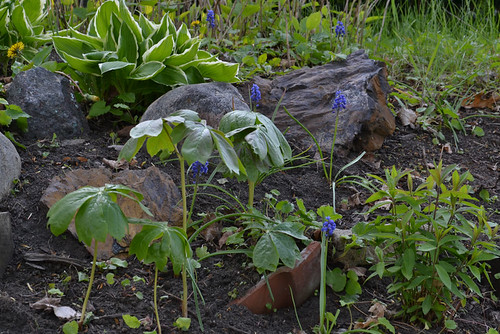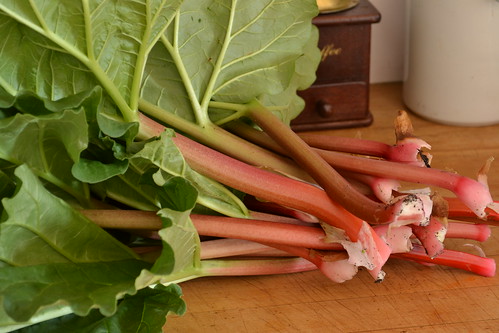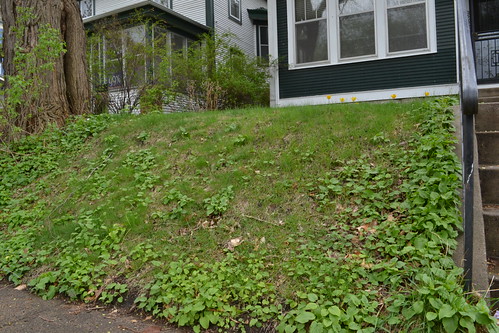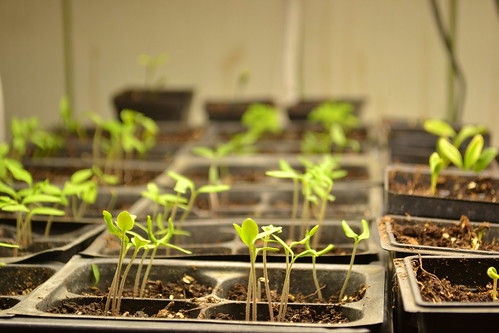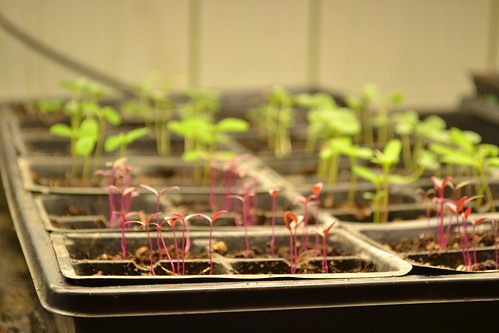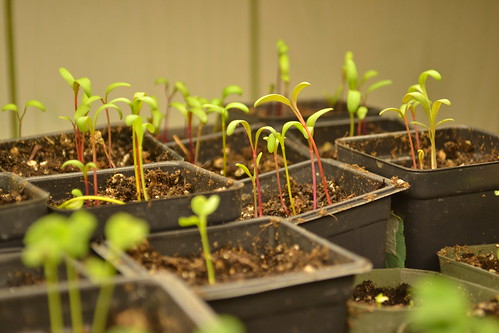Monday, April 30, 2012
weeding
oh weeding. the bane of every gardener's existence (am i right?). yesterday i dedicated a good three hours to weeding our existing front garden (looks a lot better than the last time you saw it, right?). i figured i'd better get that one under control before i start a whole new garden space. i have some kind of aggressive, spreading weed that has a very complex root system underneath the soil and i just can't seem to get ahead of it. i do my best to pull up the roots, but it's hard! during the hours i was working on this space, i alternated from feeling meditative and calm, to overwhelmed that i would never get all these weeds out, and as soon as i did, they'd just grow back anyways.
i'm definitely not anti-weed, as i'm not concerned about having a pristine looking garden space at all. really the only reason i'm concerned about the weeds is when they start choking out the plants that i want to thrive. weeding out this space made me realize how much space is still available to be filled in, so i'm hoping to transplant some things from my backyard garden areas (which are overcrowded) to the front here. maybe having less open space will deter the weeds? i'm also planning to put down a good amount of mulch.
so what to do you do about weeds? my go-to tools are just a trowel and a hand cultivator. what tools are your favorites? do you use weed-blocking landscaping fabric? i'm not a big fan, but that's just my preference. i'm open to any and all advice and experience you have!
Thursday, April 26, 2012
oh boy, kohlrabi
This week I got a roll of film developed and a few shots are from late winter/very early spring, such as the one of the seed starts above. And I thought gosh, that seems so long ago. Everything was still brown outside then! Plus those kohlrabi and broccoli starts have grown so much since then, and that was encouraging, to see how far they've come.
While they're not ready to harvest yet, there's a couple ways we really enjoyed preparing them last year, raw and cooked. They're a good snack cut into matchsticks and dipped in a little dressing. Several times I also made a kohlrabi and beet salad. We also like to stir fry chopped kohlrabi with onion, garlic, and bok choy and serve it over rice. Spring is yummy.
Monday, April 23, 2012
first harvest::rhubarb
over the weekend i enjoyed my first garden harvest of this year...rhubarb. all of these beautiful red stalks made their way over to my sister-in-law's house on saturday and were turned into a beautiful crisp and a beautiful galette in celebration of my newest nephew's baptism. i was happy to contribute this fruit from my garden (and i know i will have many more rhubarb harvests over this season). rhubarb was a food that i had never even tasted six years ago, before i moved to minnesota and i am sad that i spent so much of my life missing out on this delicious early spring beauty! since moving here, though, i've more than made up for my decades without rhubarb.
two years ago, i posted a list of rhubarb recipes that i've tried, here (along with a recipe for rhubarb orange compote). this year, i'd like to try some rhubarb vanilla ice cream. what's your favorite thing to do with rhubarb? and what has your first harvest been so far this year?
Friday, April 20, 2012
catnip insect repellent

i am pretty sensitive to insect bites and tend to swell easily.
yesterday when i was working in the garden i got bit by something close to my eye and now look like i was involved in a serious boxing match.
since i am not willing to hide inside all summer long i thought i would do a little research about making my own insect repellent.
i was excited to find a recipe made from a few simple ingredients including catnip which is something i have quite a bit of growing in my garden.
although it may have to be applied more regularly, it is claimed that catnip (nepeta) is more effective than deet.
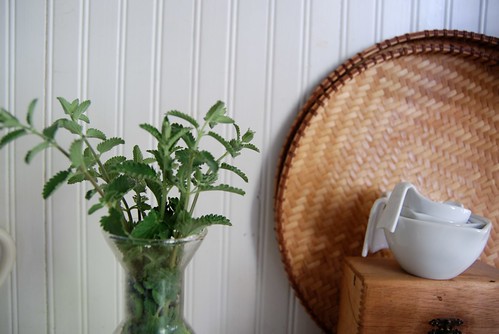
there are a few different methods of making the repellent, all of which don't require much time or materials.
to make an oil-based infusion of the plant, gather catnip leaves and stems and finely chop. fill a clean jar with the chopped greens and cover with olive oil. cap jar tightly and shake to bring air bubbles to the top. then fill completely with the oil. let sit in a cool dark place for six weeks to infuse.

an alcohol-based infusion is what i decided to try. i like the idea of spraying something cool and light onto my skin on hot summer days.
gather the catnip leaves and stems, chop and fill a jar with the greens. use 100-proof vodka to fill the jar. cap jar tightly and set aside for six weeks. after straining the alcohol from the plant, you will now have a tincture. fill a small spritzer bottle halfway with the tincture. top the rest of the bottle with water.

you will need to re-apply the catnip repellent, whichever form you choose, about every 30 minutes to maintain optimal effectiveness.
the most simple method of all is to simply take a sprig of catnip and crush it in your hands, releasing the oils and scent.

tuck it into your shirt pocket, hat, around the neckline of your clothes and other places that are exposed. You can also rub the plant directly onto your skin.
here's to keeping the bugs away!
Thursday, April 19, 2012
Naturalizing
 |
| penstemon |
One thing I love about having a garden are the surprises, the fun surprises. Not the aphid kind, which we had earlier this spring, probably as a result of a mild winter, but anyway. I mean the surprise of finding volunteer plants or plants that have reseeded themselves. At the end of a growing season, we tend to allow plants go to seed. This creates food for birds and then in the spring we find little plants popping up, that we didn't have to put there. They have naturalized. This spring there are a number of young penstemon plants popping up around the large mother plant. Likely we will let them get a little bigger and transplant them. Since plants often naturalize in places where we may not want them to stay, we have to edit. The african daisies are a plant that we always have to do this with, because they are such profuse seeders.
This spring we've also noticed marigolds and parsley popping up, which we will also relocate. Hollyhocks also weave their way in among our vegetables. Last year we transplanted some but they didn't fare well. So this year we will leave them where they are, in among lettuce rows and next to the tulips, and so forth. Such is our natural garden, and we like it that way.
Wednesday, April 18, 2012
quick meals from the garden






i am often asked how our family has the time to eat so well & on top of it all- eat the food we have grown. it is simple, really. fresh food doesn't take that much time. it only takes planning, a cutting board & a knife. maybe a pot of water if you're feeling fancy.
the lunch above was prepared on my lunch break. my husband made a big bowl of chicken salad this weekend & i purchased vegetables from the farmers' market. i added some salad greens & edible flowers from our garden to the mix. i even had time to sit down & read an article while enjoying my meal before heading back to work.
along with a simple salad, here are a few ideas for quick healthy meals at home or on the go:
- boiled broccoli & asparagus. boil until it is to your liking. add a squeeze of lemon or some freshly grated parmesan cheese.
- fried egg on top of seasonal greens
- prepare roasted root vegetables the night before. enjoy cold with a scoop of couscous or warm up in the oven.
- kale chips. crank the oven on 400 degrees. tear leaves & mix with a bit of olive oil, minced garlic & salt. place on baking sheet for 10 minutes.
enjoy!
Monday, April 16, 2012
another front yard project
like amy, i have a semi-neglected front yard. in my case, it's because our back yard gets much more sun, so i've focused more of our efforts there. when we moved into our house two and a half years ago, there were already some decent garden spaces carved out, but it's clear that the previous owners and i have different gardening styles! in our front yard, there are two beds just in front of the house that are mostly a variety of hostas, and some red-colored landscaping rock that i cannot stand. i vow that this year will be the year i finally clear it out! i'm not a big fan of the hostas either and am slowly replacing them with other plants. i've planted a lot of tulip bulbs there as well, so it's really pretty in the early spring.
closer to the sidewalk, our house is on a very small hill, so there is one garden bed on one side of the steps up from the street. i've spent the past two summers slowly replacing the hostas in this space and adding some perennial flowers and herbs (st. john's wort, chives, feverfew, and echinacea). i also seem to be in a losing battle with an aggressive spreading weed that is trying to take over the garden (any ideas what that is? or suggestions on how to fight it? i've tried ripping it up by the roots, but it just keeps coming back!)
my big project for this year is to dig up the other side of this small hill. it's partial shade, so that limits my planting options, but i'm confident that i can fill it up without too much trouble. because it's on a hill, i'll need to do some kind of minor terracing to prevent erosion (there were some attempts at this on the other side, but it's not done very well. i'm working on improving that as well). i'll probably just use some bricks that we have in our garage.
i have some plants in my overgrown backyard that i plan to move to this space: rhubarb (we have a rogue one growing in our raspberry patch!), borage, comfrey, bleeding hearts, yarrow, and a few grasses. any other suggestions for a partially shady hilly spot? bonus points if they're medicinal or can be used for dyes :)
i'm really excited to add this new space and spruce up the front of our house. and i love that amy is working on a similar project and we can check up on each other's progress as the summer moves forward.
Friday, April 13, 2012
transplanting





i don't know about you but we live on a budget. and as much as i would love to spend every penny of my weekly paycheck on plants, i have to try hard to refrain at this time of year.
to stick with our budget i have made a commitment to fill my garden this season with as many plants as possible from other people's gardens.
most gardens are in need of a little thinning of one plant or another (i know i am always looking to give away black eyed susans) so it's usually not hard to find someone looking to share a piece of their garden. heck i have even seen transplants on freecycle and craigs list.
just like thrifting, i love the thrill of plant shopping in other people's gardens. you never know what you will find. sometimes there are just the basics and sometimes you can find the score of your life.
i also like having a garden with a story. little pieces from here and there.
today i went to my mom's to dig up a few simple shade lovers. a french variety of forget-me-not, a ground covering strawberry begonia and a few miniature hostas soon filled my basket. and off i went to give them a new home and my garden another piece to it's story
Some tips when digging up and transplanting:
:: transplant on an overcast day or during the cooler morning or evening hours.
:: be prepared. bring your own tools as well as baskets and containers to hold your transplants. boxes, baskets, crates, trays and buckets work great for transporting.
:: dig deep. dig out far enough from the plant to get all the roots without breaking or damaging them. and include as much soil as possible around the root system to keep the plant from drying out.
:: water your plants lightly as soon as you dig them up. plants can go into a bit of shock when their roots are disturbed. give them a little boost with a drink of water as soon as they are dug up.
:: transplant your plants as soon as you get home. have an idea of where you want your plants to go and if possible have the holes already dug. if not, no biggie but don't leave them to sit out too long or even worse forget about them until the next day.
:: don't bite off more than you can chew. translated- don't dig up more than you can plant. i have made the mistake many a time of digging up way more plants than i realistically had time to transplant that day.
:: water everything as soon as it is planted and then every day for at least a week. the biggest mistake you can make is under watering your transplants.
Wednesday, April 11, 2012
Wild foods, part two
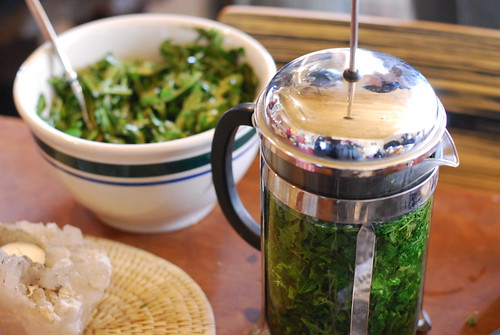
I harvested nettle tops today for a spring nettle tea. If you've never tried it before, it will surprise you. It's salty and briny and rich. I harvested quite a few nettles before being stung. The sting is mild, though, and goes away quickly. Don't let that deter you from this wonderful, mineral-rich wild food.

Dandelion greens (foraged from the yard) make a delicious spring salad for lunch. Wash the greens well and dress simply with lemon juice, olive oil, and maple syrup.
Look around your yard this week and see if you can identify nettle and dandelion and try your hand at incorporating them into a simple, spring meal. Your body will thank you.
lately

in the garden...
:: planting, planting, planting- seed & start
:: really enjoying selling starts to our local community & natural foods market
:: the sugar snaps are flowering & the french breakfast (my favorite) radishes are ready!
:: a big heap of top soil & compost in the waiting to add to our compost pile & build new beds for our tomatoes, cucumber & squash varieties
:: fennel! & dill! planted! those two might be my favorite to watch, but don't tell the others!
:: new growth in the compost that soon will be turned. do you enjoy watching life spring up from the compost pile, too?
:: the girls are loving the fresh, green grass to scratch in & munch a bit.
:: the broccoli is almost ready for harvesting. our very first successful broccoli!
:: the perennial flower bed is gorgeous right now
:: thoroughly enjoying our fresh meals & late dinners outside by candlelight
what's been happening in your garden lately?
Thursday, April 5, 2012
Blooming now : A few favorites
When I need a little quiet I walk through the garden and simply look around. Today I'm sharing three plants from our garden that are blooming.
This money plant (Lunaria annua) reseeds itself, and we find them popping up all over our garden. They are originally from heirloom seeds gathered from my Grandmother's garden years ago.
Sage
We bought this plant last year from the garden center at the end of our street and its lavender colored blooms are just beginning to open.
I like the drama of these black parrot tulips as they unfold.
Wednesday, April 4, 2012
Beginnings of Spring

Mud Season seems to have ended early this year. The soil in the garden is ready for planting, and the forsythia is on the verge of blooming.
 'Tis the season for being cheered by daffodils.
'Tis the season for being cheered by daffodils. We've got some wild edibles springing up in our yard as well. The wonderful stinging nettle is pictured above. I will be harvesting some soon. I hope to make a nettle vinegar and a nettlekopita this year. Perhaps a nettle tincture, too.
We've got some wild edibles springing up in our yard as well. The wonderful stinging nettle is pictured above. I will be harvesting some soon. I hope to make a nettle vinegar and a nettlekopita this year. Perhaps a nettle tincture, too. Here's garlic mustard (an awful invasive, but edible) which will be making its way into my salad bowl soon.
Here's garlic mustard (an awful invasive, but edible) which will be making its way into my salad bowl soon.Spring is a great time for wild edibles, especially while we're waiting for our gardens to grow. Be sure you identify the plants carefully. Refer to the information in several sources or find someone who is knowledgeable about wild edibles before you begin to incorporate wild plants into your diet.
Anyone else planning on harvesting some wild edibles this spring?
Monday, April 2, 2012
basement garden
not too much happening at our garden this week. the perennials are awakening and beginning to bloom; i've finally gotten around to uncovering them from their winter leaf blanket and it feels like everyone is breathing easier here and ready to grow. i planted some arugula and radishes last week and they are just barely beginning to sprout. meanwhile, in the basement, the seedlings are going nuts. they are almost all sprouted, with the exception of a few peppers, which are always a bit slower. and the zinnias, marigolds, and kale are beginning to grow their true leaves. it's so fun to pop down there in the mornings and check on these little guys and make sure they're all watered and happy. i'll be gone for a few days, so i'm really excited to see how much everything grows while i'm away.
Subscribe to:
Posts (Atom)



